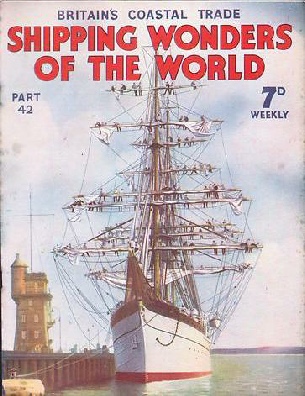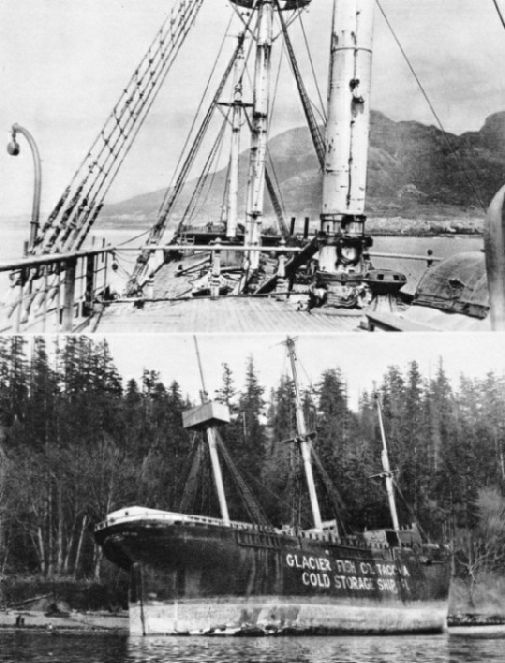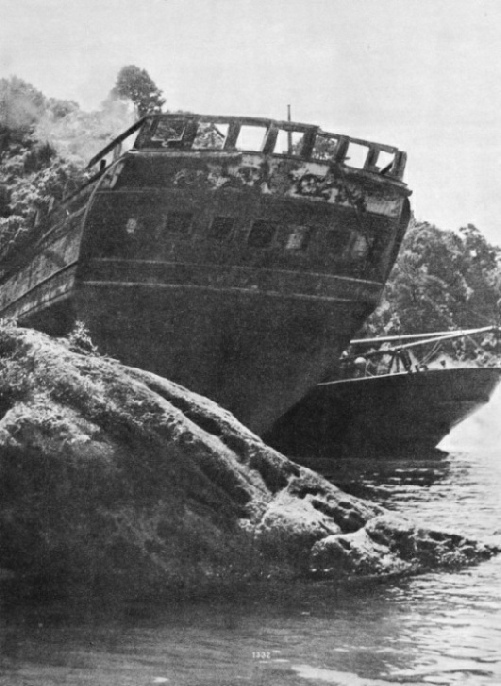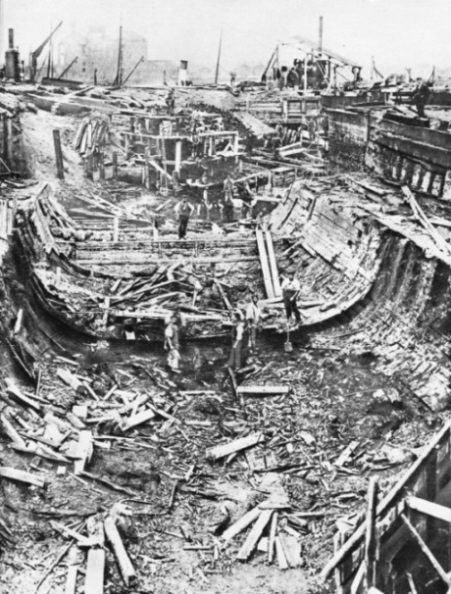
© Shipping Wonders of the World 2012-



Part 42
Part 42 of Shipping Wonders of the World was published on Tuesday 24th November 1936.
It included a centre photogravure supplement featuring the hulks of old ships, which formed part of the article The Glory is Departed.
The Cover
This week’s cover shows the Gorch Fock, the training ship of the German Navy, at Kiel. The Gorch Fock was built at Hamburg in 1933 and has a displacement tonnage of 1,486. Her principal dimensions are 200 feet by 39 ft 4 in by 15 ft. She is equipped with auxiliary diesels of 500 horse-power.

Contents of Part 42
Fifty Years in Sail - 2
Extracts from the log of the late Captain James William Holmes, concluded from part 41. Captain Holmes’s reminiscences were collated by his daughter, Mrs Nora Coughlan.
Britain’s Coastal Trade
The geographical position of the British Isles and their proximity to the mainland of Europe have given rise to an important coastwise trade, not only within British waters but also to neighbouring European coasts. The coastal trade of Great Britain has been described as the Cinderella of the transport industry.
From the Aegean to the Black Sea
One of the most important natural waterways in the world is the series of straits dividing Europe from Asia Minor - the Dardanelles, the Sea of Marmara and the Bosphorus. They link Istanbul and the Black Sea wheat and oil ports with the Mediterranean and the trade routes of the world. This is another article in the series on World Waterways.
Thames “Flat Iron” Collier
This article describes the type of vessel is known as the “flat iron” collier. She has a low superstructure and a hinging funnel, so that she can navigate under the London bridges. The Fulham was ordered by the Fulham (London) Borough Council. Under the management of Stephenson Clarke and Associated Companies Ltd., of London and Newcastle-on-Tyne, she operates between Newcastle and the Council’s generating station at Fulham.
This is the thirty-second article in the series on Merchant Ship Types.
The Glory is Departed
Beneath the dirty paint of many hulks to be seen in various parts of the world are concealed the beautiful lines of proud sailing ships that were once undisputed mistresses of the seven seas. Now that the days of sail are gone for ever, it is fitting that a record of such ships should be preserved. Some of them were lost at sea - a tragic, but fitting end. Others were condemned to the breaker’s yard. Others went to the timber trade, became coal hulks or gunnery targets.
The Glory is Departed: Photogravure Supplement
THE DESERTED DECK of the Brutus, used as a hulk near Capetown, is shown in the upper photograph. The Brutus was built at Port Glasgow in 1883 as the Sierra Pedrosa. With a gross tonnage of 1,686, she had a length of 249 feet, a beam of
38 ft 1 in and a depth of 23 ft
7 in. In September 1902 the Brutus went ashore in Table Bay. She was refloated and became a hulk.
A COLD STORAGE SHIP for the Glacier Fish Company, of Tacoma, Washington, was formerly the Glory of the Seas. One of the best examples of Donald McKay’s work, the Glory of the Seas, 2,103 tons gross, had a length of 240 ft 3 in, a bema of 44 ft 1 in and a depth of 28 ft 4 in. She was built at Boston in 1869 and, after a wonderful career, suffered this ignominious fate. In 1923 an effort was made to re-rig and preserve her, but she was deliberately burned so that her valuable copper fittings could be easily recovered.
Contents of Part 42 (continued)
Undersea Weapons
Probably the most effective of all methods of attack in naval warfare is the use of weapons such as the torpedo, the mine and the depth charge, which are particularly dangerous because they strike below the water-line.
This is the eleventh article in the series The Navy Goes to Work.
The “Rex” and the “Conte di Savoia”
Transatlantic records have been broken by the Rex and the Conte di Savoia of the Italia Line. These two vessels are the largest and fastest of the Italian luxury liners which ply between New York and the Mediterranean. We have dealt with French, American, German and British liners, and now it is the turn of Italy. The Rex and the Conte di Savoia were built for the purpose of winning for Italy the Blue Riband of the Atlantic.
This chapter is the eleventh article in the series on The World’s Largest Ships.
Battle of Trafalgar
The last of the great naval victories of Lord Nelson took place off Cape Trafalgar on October 21, 1805, and decisively established for Great Britain a sea supremacy that was not challenged for more than a century. The article is concluded in part 43.
This chapter is the fifth article in the series on Decisive Naval Actions.
The Glory is Departed - 2
CONVERTED INTO A LANDING-STAGE at Picton, New Zealand. The Edwin Fox, 836 tons, was built at Calcutta in 1853. She had a length of 144 ft 10 in, a beam of 29 ft 10 in and a depth of 23 ft 4 in. She was sold into the New Zealand emigrant trade and, when dis-rated, was fitted with refrigerating machinery and was used as a cold store for meat. She later became a hulk, and finally was used as a landing-stage, where her picturesque stern windows decoration and poop rail are still to be seen.
[Later still the hulk was purchased for one shilling and is being restored by the Edwin Fox Society]
The Glory is Departed - 3
LAID UP AT FOWEY, CORNWALL, alongside some cargo vessels, is the auxiliary barquentine Rigdin, of Southampton. Built in 1907 as the Ingrid, the Rigdin has a length of 141 ft 2 in, a beam of 29 ft 11 in and a depth of
13 ft 2 in.
The Glory is Departed - 4
THE SHIP THAT BECAME A DRY DOCK. In 1829 the Canton was sunk at Limehouse, London, to form a small dry-dock. Her stout timbers remained in such good condition that in 1898, when it became necessary to enlarge the dock, the demolition of the old ship proved difficult. The Canton was an East Indiaman of about 1,200 tons, built in 1790 and discharged from the East India Company’s service in 1811. She mounted thirty-two guns and had a crew of 130.



